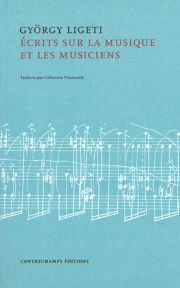Life, works and writings of Ligeti
Two books are devoted to one of the leading composers of the 20th century, who remained independent and free, as if on the periphery of the various aesthetic movements he encountered.

Karol Beffa has written the first French-language biography to cover the whole of Ligeti's life, work and personality, including his Hungarian period and his last works, particularly the piano studies, which the book's most extensive chapter precisely deciphers and analyzes. The author highlights the many and varied sources of inspiration for this unprejudiced composer, with his insatiable curiosity and limpid clarity of writing: mirrors, labyrinths, clocks and other mechanisms, geometric constructions, perspective illusions as in Escher, the depth of multiple strata, the structures of organic chemistry, fractal objects, some of his favorite writers and artists, even cartoons and comic strips, and many more. And beyond that, surprise, reflection, dreams, humor, derision and absurdity.
Always ready to evolve, to modify his writing style, as if on a permanent quest, Ligeti systematically questioned the parameters, before reintegrating them in full awareness of their contributions. Having lived under two totalitarian regimes, he was all the more wary of any sectarianism or bias - as, from the 1970s onwards, of a certain avant-garde as much as of post-modernism. Among other documents, Karol Beffa draws on personal communications from the composer and his performers, including Aimard and Boulez, as well as his writings, the third volume of the French translation of which was recently published, in an excellent translation by Catherine Fourcassié.
In this latest volume, we find the same honesty as in his musical work, both uncompromising and undogmatic, and the same independence of spirit. What's immediately striking about these writings is their clarity, conciseness and sense of concreteness. In addition to a few texts written before his exile from Hungary (including two short ethnomusicological studies), the book is divided into three equally large sections: various considerations on contemporary music (electronic music, the function of space, the teaching of composition, politics and music, the historical evolution of the importance of timbre...), analyses of the music of composers from the first half of the 20th century (above all Webern, but also Bartók, Hindemith, Ives and Mahler) and finally various writings, of unequal importance, devoted to his contemporaries, including Cerha, Kurtág or the too little-known Claude Vivier.
Karol Beffa, György Ligeti, 464 p., € 28.00, Fayard, Paris 2016, ISBN 978-2-21370124-0
György Ligeti, Écrits sur la musique et les musiciens, Translated by Catherine Fourcassié, 440 p., Fr. 28.00, Editions Contrechamps, Geneva 2014, ISBN 978-2-940068-46-3










